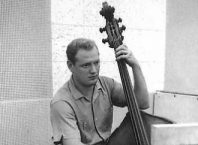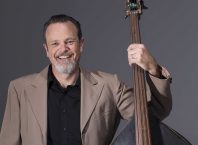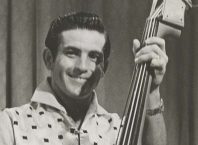In the recent years, Psychobilly popularized slap bass more than any other music genre. We often read the suggestion box on our forum and noticed that many of you requested Thomas Lorioux aka Fantomas aka Thomas Frenchy to be featured on the Art of Slap Bass. He’s been playing this style all over the world for more than 20 years with bands like Frantic Flintstones, Surf Rats, AstroZombies, Guitar Slingers (featuring Psycho legends Strangy, Doyley, Pete1) and other bands like Shaltai or amazing Kings of Nuthin’. He also recorded Slappin’ Out specially for us in his new home in Los Angeles, CA.
I’m proud to present to you here, on The Art of Slap Bass, for the first time ever:
THOMAS LORIOUX
Djordje: Welcome to California Thomas!
You recently moved to the States. Does that mean that we’ll see you more often on tour with Kings of Nuthin?
Thomas: Thanks Djordje!
The Kings have been on hold for nearly 3 years now. Everybody wanted to spend time in the real world for a while. A new album just came out so tours should follow. I’m also looking for bands here as I’m the only one in the Kings making a living out of music.
Djordje: When did you start and what inspired you to play double bass?
Thomas: I started music really late in life, I was 20 years old. I always wanted to play but didn’t know which instrument for sure, even if I was leaning towards upright bass. I was watching a few bands playing with slap bass since the mid-80’s.
Djordje: How did you learn to play?
Thomas: One day, I met a street busker, ex-psychobilly bassist who had turned to jazz. I asked him if I could try his bass and after 10 minutes I was sold. That day he showed me what he called the right position, usually used by classical and jazz players, which was using all fingers of the left hand instead of only 1 or 2 fingers as most r’n’r bassist were doing. He told me the names of the notes, and gave me some advice on exercises.
There was a café in Paris where all the street musicians hung around. There were people from all over the world, from Brazil to Russia to the US to Australia so, it often ended up in big jam sessions. I hung around there and really soon started to play in Paris subway. Some guys taught me 2 songs, probably Beatles or Rolling Stones. I played those for a week, then learned a couple more like Louis Prima and Johnny Cash till I realized there were some patterns in a lot of these songs. People were patient with me because they knew that the audience was paying more for the presence of an upright bass than the playing itself.
I never cared what kind of music I was playing; it was all the same — all about learning. I played on the streets and subways of a few European countries over the years and the music ranged from Irish folk to rockabilly to Eastern folk, country and American folk to rock.
Djordje: What are your instruments?
Thomas: I started with a basic but good Englehardt study bass, all plywood, kept it for 3 years I think. I went to Russia in 1993 and picked up an old hybrid Russian bass, with a small body and a thick neck, ebony fingerboard, lots of repaired cracks, but it was love at first sight. I still use it to this day. I also own another Russian bass, a hybrid from 1961. I’ve been told it was made in a furniture factory. It’s the opposite of my other bass, nearly a 4/4 size with a thin neck. I added an ebony fingerboard. It’s my main gigging bass.
Djordje: You’ve been using Rotosound strings for a long time now. What are the advantages of those strings over the others (steel, guts etc) in your opinion?
Thomas: I tried others but always came back to those. As I play mostly slap, they have the perfect tension for my playing, neither too loose or too tight, the slap comes out clearly and the notes as well. The notes are more in the medium range but I like that. The sound of the slap is better for me than on steel strings. I do a lot of effects with slap and those strings give me the best results so far. I really like to be able to play acoustic and for that, they’re more powerful than guts (especially A and E), and better sounding than steel.
Of course, it’s all subjective. I like the sound of gut and steel, depending on the music but they’re not for me.

Djordje: What were you using before?
Thomas: I started with steel (Thomastik Orchestra Superflexible I think), because my bass came with it. One year later, I was playing with some Russian guys in Denmark and they made me switch to guts (classical harp strings), to be able to catch up with their speed and style. Then I tried Rotosounds. Over the years, I get caught up in a new “best strings ever” that just comes out, I’ll buy or try them on someone else’s bass and after a month maximum, I’m back to Rotosound.
Djordje: What came first, pizzicato, arco or slap and how did you learn the slap technique?
Thomas: It was pizz for me. Strangely enough, I was really into the psychobilly scene but didn’t want to play that kind of music because I thought that jazz (even though I didn’t like it that much), was the highest level I could aspire to. But, I couldn’t find a teacher that wasn’t a music snob and I didn’t want to get burned out by those people. Then I met an American rockabilly guitarist who made me play slap. I watched swing/blues and rockabilly/country bassists play it around me, to pick up the tricks.
The best thing for me was going to Denmark and meeting some crazy Russians playing psychobilly and rockabilly in the streets and bars of Copenhagen. They already had a bassist, Slava, (much better than me) but as I was homeless and penniless, they took me under their wing and proposed to me to play with them. Their approach to music was like mine: take whatever you want from any kind of style and mix it with what you like, but they had an Eastern European madness to them that I wasn’t familiar with yet. Their lifestyle fitted their approach to music. We played rock’n’roll mixed up with country, ska, Eastern European folk, some weird Tom Waits ideas thrown in the mix… After that, I was ready for almost anything.
Djordje: Historically there is a lot of confusion about names for different slap patterns (read more about it here). What are the names that you use and what kind of different slap patterns do you use in your playing?
Thomas: For me, simple slap is only the string pulling/note, double is the pulling and the palm hitting the board once, triple would be the note and 2 hits with the palm…. I use a lot of the drag slap effect, which is a quick triple slap and I often let my thumb hit the fingerboard when I slap, adding or accentuating a slap.
As I’ve learned it mostly on my own, I never had to give it a proper name, I had a single slap, country slap and double. It was while talking to other people, and lately giving lessons, that I realized that what I called double most people were calling triple. Counting palm slap and string slap make sense now that I’m reading it. I’ll see if I’ll stick to it with time.
Djordje: Who are your bass and, more specifically, slap influences?
Thomas: Well, my influences range from the usual legendary names to contemporary players but I’ll start with the legends:
Willie Dixon is my favorite, especially his work with Memphis Slim, Big Boy Crawford, Ransom Knowling, Bob Haggart, and Milt Hinton. There are a few other people whom I really like, such as Pops Foster, Bam Brown (who played with Slim Gaillard when Slam Stewart quit), Calvin Ponder (who played with pianist Martha Davis), Israel Cachao who played Cuban music and mambo, Gilles Chevaucherie after I heard one song with him soloing with the Jean Paul Amoroux Boogie Machine — great slapping!
Djordje: It’s amazing that most of bass players outside of France are not familiar with Chevaucherie’s work. Do you like some other slap players nowadays?
Thomas: Yes, a lot of people, either for technique, style or, stage presence:
Vlad Viorel (from Taraf de Haidouks), Jimmy Sutton, Kevin Smith, Slava Ermichev (who is the Russian guy who taught me a lot), Larry Taylor (Tom Waits’ bassist), I discovered Nicolas Dubouchet and you, Djordje; plus all the nameless gypsies I’ve seen playing in the streets in Europe.
In the psychobilly scene, I would choose Steve Whitehouse from Frenzy, Mark Carew from Long Tall Texans, Simon from Peacocks, Jeff Roffredo, Kim Nekroman, Eric Haamer from Batmobile, Holly from Mad Sin, Dmitri from early Meantraitors (Russia), Rob Peltier from Quakes and a few others that I’m surely forgetting now.

Djordje: Most of The Art of Slap Bass readers are familiar with your work with Psychobilly bands like Frantic Flintstones, AstroZombies, Surf Rats and King of Nuthin’. You also play some Country, Irish, Klezmer and Eastern European music. How much of your work in non-billy related styles include slap bass?
Thomas: Actually, they all include slap bass. There’s a lot of slapping in eastern music and in country of course. It works really good with Irish music as well as in Klezmer. I also played some folk, ska and some more pop/rock stuff, mostly using slap when the songs allow it.
Djordje: Who are you playing with these days?
Thomas: As I just moved to Los Angeles, I’m looking for new bands here but I’m still playing in Europe with The Surf Rats and Guitar Slingers. I’m doing tours over there. In the US, I have Kings of Nuthin’ but I don’t know when the band will start playing again.
Djordje: I like your playing on the Shaltai version of Just Can’t Be Satisfied, very much. How much do you have to adjust your playing style when you play with them or with Ian Kent and the Immigrants?
Thomas: Thanks!
I don’t think I have to adjust my playing to a style. I adjust it to a song and what the feeling of it allows. My playing is more discrete if there are more instruments around, I don’t play the same with Kings of Nuthin’, which is more of an orchestra, as I do with AstroZombies, which is a trio. I don’t want to play over people’s lines, it’d be bad for the sound and the song. I’d add slap effects in less places, trying to fit them in with everybody’s playing. With a smaller line-up, I use all the space I can, trying not to overdo it. That’s mostly for recording – for stage, i give myself more freedom.
Djordje: Your playing on Frantic Flintstones’ Champagne 4 All is very influential in the Psychobilly scene. Are there any plans to play with Chuck and the guys again?
Thomas: Nothing planned. A couple of years ago, I helped them for a few shows because their bassist was busy but, that was it. I would do that again but not full time.
Djordje: How do you like to record your bass?
Thomas: Mainly acoustic. I like to put one mike in front of the left f-hole, and if possible, one mike in front of the fingerboard for the slap. I run the pick-up through the PA just to have an extra kick if I need it, to use either for extra slap or extra bass. But usually I’m not too impressed by the pick-up solution, it really has to be in the background.

Djordje: What songs that you recorded would you recommend to bass players that are interested in your slap technique?
Thomas: Maybe on the Flintstones album “champagne..”, like “Baby Bent Double”, “Champagne for All” or, on the Astrozombies live album called “Burgundy Livers”, songs like “Bang Bang” and “Bonnie and Clyde”.
Djordje: Are there any tours planned in the next few months?
Thomas: I might go to Europe in October for a short Surf Rats tour and, as Kings of Nuthin have finally released the new album, we’re talking about Europe in November/December. Then Surf Rats in US/Mexico in January.
Djordje: What are your preferences for amps and pickups?
Thomas: I’m not at all into that side of music. That’s probably the reason why I like playing acoustic and busking so much. Lately I use the slap part of the K&K and the Realist for the bass, I run them both through a small mixing board, and then through my amp.
As for amps, I mainly use Ashdown. I like the simplicity of it. I have one of their early 300W bass combos, but I’d like to use their newer ones.
I often have to borrow basses or amps or both. Sometimes what I thought was a crappy amp brand turns out to be working good with that particular bass, or the opposite happens: having endless problems with a supposedly great amp for upright bass.
Djordje: What do you suggest to younger players to practice on a daily basis?
Thomas: Well, I would start by playing over a slow easy song to warm up, something where you don’t have to concentrate too much, playing it pizz, and then slapping. I’d start using simple slap, then double… until I try all the tricks I know, mixing them in one song. Then change rhythm to something faster or syncopated. What I also do is to block the strings with the left hand and play just slap, changing from string to string, making rhythmic patterns, from slow to fast and back again. I also find it a good exercise to try to pick up bass lines or chord progressions from songs I don’t know, good for ear-training and for learning how to jam with people.
Djordje: Thank you for finding time to do this interview and hope to see you play in the US sometime soon!
Thomas: Thanks for interviewing me and for doing the Art of Slap Bass website!
It’s great to be able to talk with slap bassists from other scenes and to learn new ways of playing. It’s about time slap art comes back to its original place in music and not be frowned upon by other bassists, especially in scenes where it used to be the normal way of playing.
If you want to ask Thomas a question, you can do that on our forum here




